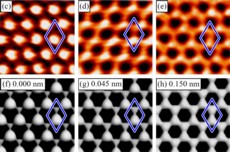Home > Press > New Technique Controls Graphite to Graphene Transition
 |
| The top three images of graphite are from the experiment and the lower three images were produced through theoretical calculations. The images from left to right show more displacement of the top layer of graphite and its transition to graphene. |
Abstract:
University of Arkansas physicists have found a way to systematically study and control the transition of graphite, the "lead" found in pencils, to graphene, one of the strongest, lightest and most conductive materials known, an important step in the process of learning to use this material in modern day technology.
New Technique Controls Graphite to Graphene Transition
Fayetteville, AR | Posted on July 2nd, 2012Peng Xu, Paul Thibado, Yurong Yang, Laurent Bellaiche and their colleagues report their findings in the journal Carbon.
Physicists at the University of Manchester first isolated graphene, a one atom thick sheet of carbon atoms, by using Scotch tape to lift only the top layer off of the other layers of graphite. Electrons moving through graphite have mass and encounter resistance, but electrons moving through graphene are massless and encounter almost no resistance, which makes graphene an excellent candidate material for future energy needs and for quantum computing for enormous calculations while using little energy.
However, graphene is a new material only discovered in 2004, and many things remain unknown about its properties.
"The transition from graphite to graphene can be random," said Xu. "Our idea was to control this."
The researchers used a new technique called electrostatic manipulation scanning tunneling microscopy to "lift" the top layer of graphite, creating graphene. Scientists have traditionally used scanning tunneling microscopy on a stationary surface, but this new technique uses a moving surface to move between graphite and graphene.
"Not only can we make it happen, but we can control the process," Xu said.
Using this technique, the researchers can tell how much force it takes to create graphene and how much distance exists between graphene and the graphite as well as to track the total energy of the process.
How the electron acquires its mass is a fundamental topic and is related to particle physicists' hunt for the Higgs boson, a long-hypothesized elementary particle that has predicted properties, such as a lack of spin and electric charge, but that does not have a predicted value for mass. Being able to move electrons between a massive and massless state allows scientists to study this duality and how it works. The level of control the scientists have over the process will allow them to figure out possible ways to use graphene for advancing this understanding.
Xu and his colleagues are researchers in the J. William Fulbright College of Arts and Sciences.
####
For more information, please click here
Contacts:
Peng Xu, physics
J. William Fulbright College of Arts and Sciences
479-575-6178
Melissa Blouin
director of science and research communication
University Relations
479-575-3033
Copyright © University of Arkansas, Fayetteville
If you have a comment, please Contact us.Issuers of news releases, not 7th Wave, Inc. or Nanotechnology Now, are solely responsible for the accuracy of the content.
| Related News Press |
News and information
![]() Researchers develop molecular qubits that communicate at telecom frequencies October 3rd, 2025
Researchers develop molecular qubits that communicate at telecom frequencies October 3rd, 2025
![]() Next-generation quantum communication October 3rd, 2025
Next-generation quantum communication October 3rd, 2025
![]() "Nanoreactor" cage uses visible light for catalytic and ultra-selective cross-cycloadditions October 3rd, 2025
"Nanoreactor" cage uses visible light for catalytic and ultra-selective cross-cycloadditions October 3rd, 2025
Physics
![]() Quantum computers simulate fundamental physics: shedding light on the building blocks of nature June 6th, 2025
Quantum computers simulate fundamental physics: shedding light on the building blocks of nature June 6th, 2025
![]() A 1960s idea inspires NBI researchers to study hitherto inaccessible quantum states June 6th, 2025
A 1960s idea inspires NBI researchers to study hitherto inaccessible quantum states June 6th, 2025
![]() Magnetism in new exotic material opens the way for robust quantum computers June 4th, 2025
Magnetism in new exotic material opens the way for robust quantum computers June 4th, 2025
Graphene/ Graphite
![]() Electrifying results shed light on graphene foam as a potential material for lab grown cartilage June 6th, 2025
Electrifying results shed light on graphene foam as a potential material for lab grown cartilage June 6th, 2025
Discoveries
![]() Researchers develop molecular qubits that communicate at telecom frequencies October 3rd, 2025
Researchers develop molecular qubits that communicate at telecom frequencies October 3rd, 2025
![]() Next-generation quantum communication October 3rd, 2025
Next-generation quantum communication October 3rd, 2025
![]() "Nanoreactor" cage uses visible light for catalytic and ultra-selective cross-cycloadditions October 3rd, 2025
"Nanoreactor" cage uses visible light for catalytic and ultra-selective cross-cycloadditions October 3rd, 2025
Announcements
![]() Rice membrane extracts lithium from brines with greater speed, less waste October 3rd, 2025
Rice membrane extracts lithium from brines with greater speed, less waste October 3rd, 2025
![]() Researchers develop molecular qubits that communicate at telecom frequencies October 3rd, 2025
Researchers develop molecular qubits that communicate at telecom frequencies October 3rd, 2025
![]() Next-generation quantum communication October 3rd, 2025
Next-generation quantum communication October 3rd, 2025
![]() "Nanoreactor" cage uses visible light for catalytic and ultra-selective cross-cycloadditions October 3rd, 2025
"Nanoreactor" cage uses visible light for catalytic and ultra-selective cross-cycloadditions October 3rd, 2025
|
|
||
|
|
||
| The latest news from around the world, FREE | ||
|
|
||
|
|
||
| Premium Products | ||
|
|
||
|
Only the news you want to read!
Learn More |
||
|
|
||
|
Full-service, expert consulting
Learn More |
||
|
|
||








